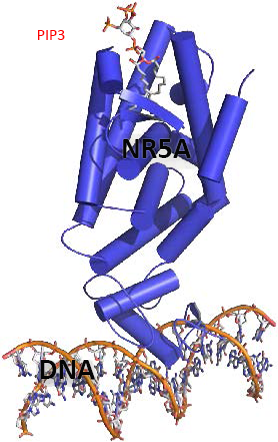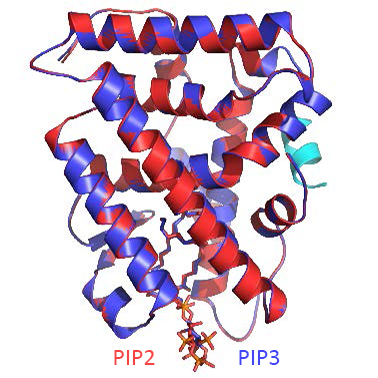Finding drugs to inhibit NR5A
Ray Blind, Ph.D., Discovery Grant 2016
Introduction:

A 2016 American Cancer Society report revealed that incidence rates have been decreasing for almost all cancers in the United States since 1999. Some notable exceptions are colorectal cancer in patients under age 50 and pancreatic cancer in every demographic. In these tenacious cancers, the NR5A nuclear receptors are known to bind DNA and activate important cancer-related genes (Fig 1), making NR5A a historically high-value drug target in both cancer and diabetes. Accordingly, the drug industry has led massive efforts targeting NR5A for many years. Despite these efforts, there are no approved therapeutics targeting NR5A, for less than clear reasons.
The few drug-like molecules directed against NR5A that exist can indeed decrease the growth of pancreatic and colorectal cancer cells. However, these drugs have not been developed because it is not clear how the drugs inhibit NR5A. Thus, in order to get new NR5A drugs into clinical trials, we must understand how NR5A is inhibited so that they can be optimized.
Here, we propose an innovative hypothesis that simultaneously explains why past NR5A drug efforts failed while providing a clear path forward based on a novel NR5A regulatory mechanism we recently discovered. If we are correct, the work proposed here will provide drug companies with a new way to find NR5A drugs, thus incentivizing companies to apply their resources to investigate innovative approaches to solve colorectal and pancreatic cancer.
Background:
Nuclear receptors work by binding DNA, resulting in gene activation. This process occurs only when the nuclear receptor binds to a hormone, such as the hormone estrogen binding to the estrogen nuclear receptor. In the case of NR5A there are two natural hormones: PIP2 which inhibits NR5A, and PIP3 which activates NR5A (Fig 2). Regardless, the established dogma is that hormones change the shape of the nuclear receptor from an “inactive” shape to an “active” shape. Thus, it is assumed that NR5A drugs should also attempt to induce the “inactive” shape, and that’s how everyone has tried to identify NR5A drugs, with very little success.

However, we tested whether this dogma was actually true. Our studies showed that no hormones or drugs caused any detectable shape changes in NR5A (Fig 2). Instead, we discovered that the natural hormone actually activates NR5A by acting as “molecular glue” - the hormone forms a molecular bridge between NR5A and important cancer regulatory proteins.
The details of how NR5A is activated are very important for drug design. The way everyone has screened for drugs assumed NR5A is regulated by the shape change mechanism – but our data showing that NR5A does not change shape suggests everyone has been screening for NR5A drugs incorrectly. But we present a clear path forward to solve that problem!
Specific Aim:
Based on our mechanistic data, we recently received the highest score of all grants for a prestigious Vanderbilt Discovery Award through the Diabetes Center. That work develops a new type of NR5A drug screen that applies our new mechanism to look for drugs that activate NR5A for use in non-alcoholic fatty liver disease patients. Using VICC Ambassadors Discovery Grant funding, we will test the “cast-off” drugs from that innovative drug screen, to identify new anti-cancer drugs that inhibit NR5A and prevent the growth of human pancreatic and colorectal cancer cell lines. We hope this seed funding leads to a large federal grant to characterize the drugs.
The development of the new drug screen is already well underway. The novel anti-cancer drugs identified will provide a pharmacological scaffold from which an entire new class of drugs could be rapidly developed. Our proposed studies also provide strong proof-of-principal for drug companies to invest in their NR5A anti-cancer drug development efforts, better leveraging their massive drug libraries to fight pancreatic and colorectal cancers. By repurposing our fatty liver drug screen to discover anti-cancer drugs, your support will synergize with other resources at Vanderbilt to highlight the highly interdisciplinary nature of the VICC.



